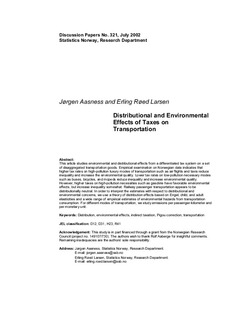Distributional and environmental effects of taxes on transportation
Working paper

Åpne
Permanent lenke
http://hdl.handle.net/11250/180305Utgivelsesdato
2002Metadata
Vis full innførselSamlinger
- Discussion Papers [1003]
Sammendrag
Abstract:
This article studies environmental and distributional effects from a differentiated tax system on a set of disaggregated transportation goods. Empirical examination on Norwegian data indicates that higher tax rates on high-pollution luxury modes of transportation such as air flights and taxis reduce inequality and increase the environmental quality. Lower tax rates on low-pollution necessary modes such as buses, bicycles, and mopeds reduce inequality and increase environmental quality. However, higher taxes on high-pollution necessities such as gasoline have favorable environmental effects, but increase inequality somewhat. Railway passenger transportation appears to be distributionally neutral. In order to interpret the estimates with respect to distributional and environmental concerns, we use a theory of distribution effects based on Engel, child, and adult elasticities and a wide range of empirical estimates of environmental hazards from transportation consumption. For different modes of transportation, we study emissions per passenger-kilometer and per monetary unit.
Keywords: Distribution, environmental effects, indirect taxation, Pigou correction, transportation